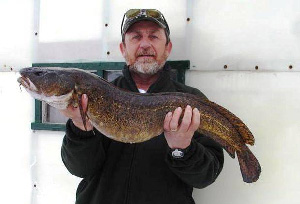Burbot/Freshwater Cusk
Lota lota
 Distribution: Burbot are found throughout the world in northern latitudes. Their range in North America extends south from Canada to Connecticut on the east coast and Oregon on the west coast. In New Hampshire, burbot are found in large lakes which maintain cold temperatures in deep water during the warmer months. They may also be found in cold water rivers and streams in the Connecticut, upper Merrimack, Saco, and Androscoggin River drainages.
Distribution: Burbot are found throughout the world in northern latitudes. Their range in North America extends south from Canada to Connecticut on the east coast and Oregon on the west coast. In New Hampshire, burbot are found in large lakes which maintain cold temperatures in deep water during the warmer months. They may also be found in cold water rivers and streams in the Connecticut, upper Merrimack, Saco, and Androscoggin River drainages.
Description: The burbot is the only freshwater member of the cod family. It has an eel shaped body with a large mouth and a single barbell dangling from its lower jaw. The skin is smooth in appearance, with very small scales and olive brown to black mottled markings over a cream colored under body. The anal and second dorsal fins are elongated, extending from the midpoint of the body to the base of the caudal fin.
Species commonly confused with: None
Habitat: Large, deep lakes and cold water rivers and streams.
Life History: The Burbot is the only fish species in New Hampshire that is known to spawn under the ice in mid to late winter. Female burbot are extremely productive, with larger individuals capable of laying over 1,000,000 eggs. Spawning takes place over shallow reefs or shoals in large lakes where currents keep the gravel substrate free of silt. Multiple males writhe around a female as eggs are released into the water column. Eggs gradually settle to the bottom and hatch in early spring.
As with lake trout, burbot are restricted to the colder water below the thermocline of deep lakes during the summer. Burbot also inhabit cold water rivers and streams and are sometimes encountered during electrofishing surveys for brook trout. Invertebrates and fish are the main prey of burbot as they forage along the bottom. Crayfish are an important food source when they are available. Lake dwelling individuals can obtain much larger sizes (State Record-Lake Winnipesaukee 34.5 inches and 12.22 pounds) than those found in rivers and streams. Populations found in flowing systems rarely obtain lengths greater than 12 inches.
Origin: Native
 Conservation/Management: Burbot populations appear secure in New Hampshire, but more information is needed to monitor the status of this species. The burbot is a cold water species that is potentially vulnerable to climate change. It is rarely found where the water temperature exceeds 70°F.
Conservation/Management: Burbot populations appear secure in New Hampshire, but more information is needed to monitor the status of this species. The burbot is a cold water species that is potentially vulnerable to climate change. It is rarely found where the water temperature exceeds 70°F.
As the climate warms in the northeast, rivers and streams at the southern end of the species’ range may no longer have suitable temperatures for supporting burbot populations. There may also be a reduction in the total area of deep, cold water habitat in lakes and ponds that support cold water fish species in the northeast. Burbot populations in lakes and ponds may be vulnerable to the impacts of pollution, such as nutrient loading and acid or mercury deposition. Over harvest has the potential to impact burbot populations in some waterbodies, although burbot are less popular with anglers than other cold water fish such as trout and salmon



